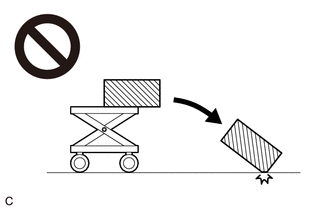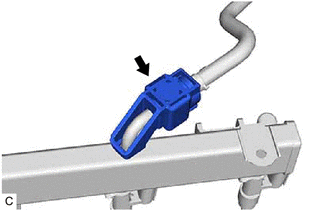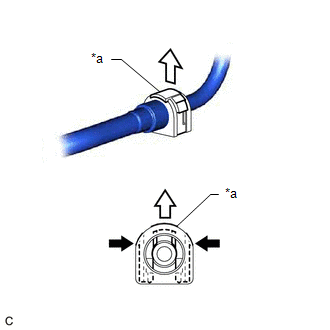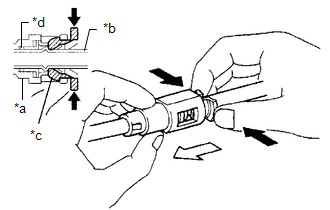Toyota Corolla Cross: Precaution
PRECAUTION
CAUTION:
- Never perform work on fuel system components near any possible ignition sources.
.png)
- Vaporized fuel could ignite, resulting in a serious accident.
- Do not perform work on fuel system components without first disconnecting the cable from the negative (-) auxiliary battery terminal.
.png)
- Sparks could cause vaporized fuel to ignite, resulting in a serious accident.
- The fuel tank assembly is very heavy. Be sure to follow the procedure described in the repair manual, or the fuel tank assembly may fall off the engine lifter.

- To prevent serious injury due to fuel spray from the high-pressure fuel lines, always discharge fuel system pressure before removing any fuel system components.
.png)
BEFORE WORKING ON FUEL SYSTEM
(a) Before inspecting and repairing the fuel system, disconnect the cable from the negative (-) auxiliary battery terminal.
NOTICE:
After turning the ignition switch off, waiting time may be required before disconnecting the cable from the negative (-) auxiliary battery terminal.
Click here .gif)
(b) Do not smoke or work near fire when handling the fuel system.
(c) Keep fuel away from rubber or leather parts.
DISCHARGE FUEL SYSTEM PRESSURE
CAUTION:
- Make sure the engine coolant temperature is 60°C (140°F) or less when performing this procedure.
- Perform the following procedure to prevent fuel from spraying before removing any fuel system parts.
- Pressure will still remain in the fuel lines even after performing the following procedure. When disconnecting a fuel line, cover it with a piece of cloth to prevent fuel from spraying or coming out.
(a) When discharging fuel system pressure by disconnecting the EFI MAIN NO. 2 relay:
(1) Remove the No. 1 relay block cover.
(2) Remove the EFI MAIN NO. 2 relay.
(3) Remove the No. 1 engine under cover assembly.
Click here
.gif)
(4) Disengage the claw and raise the lock lever to disconnect the No. 6 engine wire connector as shown in the illustration.
.png)
|
*a | Lock Lever |
(5) Start the engine. After the engine has stopped on its own, turn the ignition switch off.
NOTICE:
Do not increase the engine speed or drive the vehicle while waiting for the engine to stop on its own.
(6) Crank the engine again and make sure that the engine does not start.
HINT:
DTC P008700 (Fuel Rail / System Pressure - Too Low) or P017100 (System Too Lean Bank 1) may be stored. Clear the DTCs before proceeding to the next step.
Click here .gif)
(7) Remove the fuel tank cap assembly and discharge the pressure from the fuel tank assembly.
(8) Disconnect the cable from the negative (-) auxiliary battery terminal.
Click here .gif)
(9) Connect the No. 6 engine wire connector and push down the lock lever to engage the claw as shown in the illustration.
.png)
|
*a | Lock Lever |
(10) Install the No. 1 engine under cover assembly.
Click here
.gif)
(11) Install the EFI MAIN NO. 2 relay.
(12) Install the No. 1 relay block cover.
(b) When discharging fuel system pressure by disconnecting the fuel pump connector:
(1) Remove the rear floor service hole cover.
Click here
.gif)
(2) Disconnect the fuel suction tube with pump and gauge assembly connector.

|
*A | for 2WD |
|
*B | for AWD |
(3) Remove the No. 1 engine under cover assembly.
Click here
.gif)
(4) Disengage the claw and raise the lock lever to disconnect the No. 6 engine wire connector as shown in the illustration.
.png)
|
*a | Lock Lever |
(5) Start the engine. After the engine has stopped on its own, turn the ignition switch off.
NOTICE:
Do not increase the engine speed or drive the vehicle while waiting for the engine to stop on its own.
(6) Crank the engine again and make sure that the engine does not start.
HINT:
DTC P008700 (Fuel Rail / System Pressure - Too Low) or P017100 (System Too Lean Bank 1) may be stored. Clear the DTCs before proceeding to the next step.
Click here .gif)
(7) Remove the fuel tank cap assembly and discharge the pressure from the fuel tank sub-assembly.
(8) Disconnect the cable from the negative (-) auxiliary battery terminal.
Click here .gif)
(9) Connect the No. 6 engine wire connector and push down the lock lever to engage the claw as shown in the illustration.
.png)
|
*a | Lock Lever |
(10) Install the No. 1 engine under cover assembly.
Click here
.gif)
(11) Connect the fuel suction tube with pump and gauge assembly connector.
(12) Install the rear floor service hole cover.
Click here
.gif)
(13) Initialization after reconnecting auxiliary battery terminal.
HINT:
When disconnecting and reconnecting the auxiliary battery, there is an automatic learning function that completes learning when the respective system is used.
Click here .gif)
FUEL LINE
(a) When disconnecting a high-pressure fuel line, a large amount of fuel will spray. Perform the following procedure:
(1) Discharge fuel system pressure.
(2) Disconnect the fuel tube.
(3) Drain the fuel remaining inside the fuel tube into a container.
(4) Cover the disconnected fuel pipe and fuel tube connector with plastic bags to prevent damage and contamination.
(b) Quick Type A:
Perform the following procedure when disconnecting a fuel tube connector.
NOTICE:
Remove any dirt or foreign matter on the fuel tube connector and fuel pipe before performing this work.
(1) Clamp Type A (EFI Fuel Pipe Clamp):
Open the cover of the EFI fuel pipe clamp and remove the EFI fuel pipe clamp from the fuel tube connector.
.png)
.png) |
Open |
.png) |
Pull |
(2) Clamp Type B (Fuel Pipe Clamp):

Remove the fuel pipe clamp from the fuel tube connector.
(3) Check that there is no dirt or other foreign matter around the fuel tube connector before disconnecting it. Clean the joint if necessary.
(4) While holding the retainer at the positions shown in the illustration, pull up the retainer to disengage the lock claws.

|
*a | Retainer |
.png) |
Retainer Holding Position |
.png) |
Pull out |
(5) Pull up the retainer while holding it at the positions shown in the illustration and pull off the fuel tube connector.

|
*a | Retainer |
|
*b | Fuel Pipe |
|
*c | Fuel Tube Connector |
|
*d | O-ring |
|
*e | Nylon Tube |
.png) |
Retainer Holding Position |
.png) |
Pull out |
.png) |
Pull off |
(6) If the fuel tube connector and fuel pipe are stuck, push and pull the fuel tube connector to release it. Pull the fuel tube connector off of the fuel pipe carefully.
NOTICE:
- Do not scratch or allow any foreign matter to get on the parts when disconnecting them as the fuel tube connector has O-rings that seal the pipe (fuel pipe).
- Do not bend, twist, pinch or kink the nylon tube.
(7) Check that there is no foreign matter on the sealing surfaces of the disconnected fuel lines. Clean them if necessary.
(8) Cover the disconnected fuel pipe and fuel tube connector with plastic bags to prevent damage and contamination.
(c) Quick Type A:
Perform the following procedure when connecting a fuel tube connector.
NOTICE:
Check if there is any damage or foreign matter on the connecting parts of the fuel lines.
(1) Align the fuel tube connector with the fuel pipe, push the fuel tube connector onto the fuel pipe, then push in the retainer to secure the connection.
NOTICE:
Confirm that the retainer makes a "click" sound when pushed.
HINT:
If it is difficult to push the fuel tube connector onto the fuel pipe, apply a small amount of clean gasoline to the tip of the fuel pipe.

|
*a | Retainer |
.png) |
Push |
.png) |
Push in |
(2) After connecting the fuel lines, check that the fuel pipe and fuel tube connector are securely connected by pulling on them.
(3) Clamp Type A (EFI Fuel Pipe Clamp):
Install the EFI fuel pipe clamp to the fuel tube connector and close the cover of the EFI fuel pipe clamp.
(4) Clamp Type B (Fuel Pipe Clamp):
Install the fuel pipe clamp to the fuel tube connector.
(5) Inspect for fuel leaks.
Click here
.gif)
(d) Quick Type B:
Perform the following procedure when disconnecting a fuel tube connector.
NOTICE:
Remove any foreign matter on the fuel tube connector and fuel pipe before performing this work.
(1) Disengage the 2 claws of the retainer. Pull out the retainer and disconnect the fuel tube connector from the fuel pipe.
NOTICE:
Be sure to disconnect the fuel tube connector by hand.

|
*a | Retainer |
|
*b | Fuel Pipe |
|
*c | Fuel Tube Connector |
|
*d | O-ring |
|
*e | Claw |
|
*f | Nylon Tube |
.png) |
Push |
.png) |
Pull out |
.png) |
Pull off |
(2) If the fuel tube connector and fuel pipe are stuck, push and pull the fuel tube connector to release it. Pull the fuel tube connector off of the fuel pipe carefully.
NOTICE:
- Be sure to disconnect the fuel tube connector by hand.
- Do not scratch or allow any foreign matter to get on the parts when disconnecting them as the fuel tube connector has O-rings that seal the pipe (fuel pipe).
- Do not bend, twist, pinch or kink the nylon tube.
(3) Check that there is no foreign matter on the sealing surfaces of the disconnected fuel lines. Clean them if necessary.
(4) Cover the disconnected fuel pipe and fuel tube connector with plastic bags to prevent damage and contamination.
(e) Quick Type B:
Perform the following procedure when connecting a fuel tube connector.
NOTICE:
Check that there is no damage or foreign matter on the connecting parts of the fuel lines.
(1) Align the fuel tube connector with the fuel pipe, push the fuel tube connector onto the fuel pipe, then push in the retainer to engage the 2 claws.

|
*a | Retainer |
|
*b | Claw |
.png) |
Push |
.png) |
Push in |
NOTICE:
Confirm that the retainer makes a "click" sound when pushed.
HINT:
If it is difficult to push the fuel tube connector onto the fuel pipe, apply a small amount of clean gasoline to the tip of the fuel pipe.
(2) After connecting the fuel lines, check that the fuel pipe and fuel tube connector are securely connected by pulling on them.
(3) Inspect for fuel leaks.
Click here
.gif)
(f) Quick Type C:
Perform the following procedure when disconnecting a fuel tube connector.
NOTICE:
Remove any foreign matter on the fuel tube connector and fuel pipe before performing this work.
(1) Pinch the retainer of the fuel tube connector, and then pull the fuel tube connector off of the fuel pipe.

|
*a | Fuel Tube Connector |
|
*b | Fuel Pipe |
|
*c | Retainer |
|
*d | O-ring |
.png) |
Pinch |
.png) |
Pull off |
NOTICE:
Be sure to disconnect the fuel tube connector by hand.
(2) If the fuel tube connector and fuel pipe are stuck, push and pull the fuel tube connector to release it. Pull the fuel tube connector off of the fuel pipe carefully.
NOTICE:
- Be sure to disconnect the fuel tube connector by hand.
- Do not scratch or allow any foreign matter to get on the parts when disconnecting them as the fuel tube connector has an O-ring that seals the pipe (fuel pipe).
(3) Check that there is no foreign matter on the sealing surfaces of the disconnected fuel lines. Clean them if necessary.
(4) Cover the disconnected fuel pipe and fuel tube connector with plastic bags to prevent damage and contamination.
(g) Quick Type C:
Perform the following procedure when connecting a fuel tube connector.
NOTICE:
Check that there is no damage or foreign matter on the connecting parts of the fuel lines.
(1) Align the fuel tube connector with the fuel pipe, and push them together until the fuel tube connector makes a "click" sound. If it is difficult to push the fuel pipe into the fuel tube connector, apply a small amount of clean gasoline to the tip of the fuel pipe and reinsert it.

.png) |
Pull |
(2) After connecting the fuel lines, check that the fuel pipe and fuel tube connector are securely connected by pulling on them.
(3) Inspect for fuel leaks.
Click here
.gif)
(h) Quick Type D:
Perform the following procedure when disconnecting a fuel tube connector.
NOTICE:
Remove any foreign matter on the fuel tube connector and fuel pipe before performing this work.
(1) Pull out the retainer to disengage the lock claws and pull off the fuel tube connector.

|
*a | Retainer |
|
*b | Fuel Pipe |
|
*c | Fuel Tube Connector |
|
*d | O-ring |
.png) |
Pull out |
.png) |
Pull off |
(2) If the fuel tube connector and fuel pipe are stuck, push and pull the fuel tube connector to release it. Pull the fuel tube connector off of the fuel pipe carefully.
NOTICE:
Do not scratch or allow any foreign matter to get on the parts when disconnecting them as the fuel tube connector has O-rings that seal the pipe (fuel pipe).
(3) Check that there is no foreign matter on the sealing surfaces of the disconnected fuel lines. Clean them if necessary.
(4) Cover the disconnected fuel pipe and fuel tube connector with plastic bags to prevent damage and contamination.
(i) Quick Type D:
Perform the following procedure when connecting a fuel tube connector.
NOTICE:
Check that there is no damage or foreign matter on the connecting parts of the fuel lines.
(1) Align the fuel tube connector with the fuel pipe, push the fuel tube connector onto the fuel pipe, then push in the retainer to secure the connection.
NOTICE:
Confirm that the retainer makes a "click" sound when pushed.
HINT:
If it is difficult to push the fuel tube connector onto the fuel pipe, apply a small amount of clean gasoline to the tip of the fuel pipe.

|
*a | Retainer |
.png) |
Push |
.png) |
Push in |
(2) After connecting the fuel lines, check that the fuel pipe and fuel tube connector are securely connected by pulling on them.
(3) Inspect for fuel leaks.
Click here
.gif)
(j) Quick Type E:
Perform the following procedure when disconnecting a fuel tube connector.
NOTICE:
Remove any foreign matter on the fuel tube connector and fuel pipe before performing this work.
(1) Check that there is no foreign matter around the fuel tube connector before disconnecting it. Clean it if necessary.
(2) While holding the retainer at the positions shown in the illustration, pull up the retainer to disengage the lock claws.

|
*a | Retainer |
.png) |
Retainer Holding Position |
.png) |
Pull out |
(3) Pull up the retainer while holding it at the positions shown in the illustration and pull off the fuel tube connector.

|
*a | Retainer |
|
*b | Fuel Pipe |
|
*c | Fuel Tube Connector |
|
*d | O-ring |
|
*e | Nylon Tube |
.png) |
Retainer Holding Position |
.png) |
Pull out |
.png) |
Pull off |
(4) If the fuel tube connector and fuel pipe are stuck, push and pull the fuel tube connector to release it. Pull the fuel tube connector off of the fuel pipe carefully.
NOTICE:
- Do not scratch or allow any foreign matter to get on the parts when disconnecting them as the fuel tube connector has O-rings that seal the pipe (fuel pipe).
- Do not bend, twist, pinch or kink the nylon tube.
(5) Check that there is no foreign matter on the sealing surfaces of the disconnected fuel lines. Clean them if necessary.
(6) Cover the disconnected fuel pipe and fuel tube connector with plastic bags to prevent damage and contamination.
(k) Quick Type E:
Perform the following procedure when connecting a fuel tube connector.
NOTICE:
Check that there is no damage or foreign matter on the connecting parts of the fuel lines.
(1) Align the fuel tube connector with the fuel pipe, push the fuel tube connector onto the fuel pipe, then push in the retainer to secure the connection.
NOTICE:
Confirm that the retainer makes a "click" sound when pushed.
HINT:
If it is difficult to push the fuel tube connector onto the fuel pipe, apply a small amount of clean gasoline to the tip of the fuel pipe.

|
*a | Retainer |
.png) |
Push |
.png) |
Push in |
(2) After connecting the fuel lines, check that the fuel pipe and fuel tube connector are securely connected by pulling on them.
(3) Inspect for fuel leaks.
Click here
.gif)
(l) Observe the following precautions when handling a nylon tube:
NOTICE:
- Do not twist the nylon tube of the fuel tube connector or fuel tube connector when connecting it.
- Do not remove the Ethylene Propylene Diene Monomer (EPDM) rubber protector on the outside of the nylon tube.
- Do not bend, twist, pinch or kink the nylon tube.

|
*a | Fuel Tube Connector |
|
*b | Nylon Tube |
|
*c | Ethylene Propylene Diene Monomer (EPDM) Rubber Protector |
FUEL SUCTION TUBE WITH PUMP AND GAUGE ASSEMBLY
NOTICE:
Do not disconnect the tube shown in the illustration when disassembling the fuel suction tube with pump and gauge assembly. Doing so will cause reassembly of the fuel suction tube with pump and gauge assembly to be impossible as the tube is pressed into the fuel suction plate sub-assembly.

|
*A | for 2WD |
|
*B | for AWD |
|
*a | Tube |
INSPECT FOR FUEL LEAK
(a) Check that there are no fuel leaks from the fuel system after doing any maintenance or repairs.
Click here .gif)


